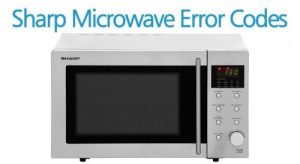
You might be wondering why these error codes even exist. Think of them as secret messages your microwave sends to you, telling you what’s wrong. It’s much like when your phone shows low battery – it’s not something to panic about but definitely something that needs a closer look. But don’t fret! Understanding what this code means and when to call in the pros can save you a lot of time and maybe even some cash.
Understanding Error Code OE
Alright, let’s dive a little deeper into what the OE error code actually means. It’s not just a random bunch of letters. OE stands for “Open Error.” It sounds strange, right? But here’s what’s happening: the microwave is sensing that something is off with its door. It’s like if your fridge door was slightly open – it just won’t work right until everything’s properly sealed up.
Why does this happen? Well, your microwave has little sensors (think of them like tiny security cameras) that make sure the door is completely closed before the microwave turns on. This is a safety feature because no one wants microwaves escaping into their kitchen! If those sensors aren’t happy or aren’t registering that the door is fully shut, it screams “OE!” It could be something as simple as a door that’s not pushed all the way in or something a bit more complex like a faulty latch or sensor.
Now, let’s talk more about what the OE code is trying to protect you from. Imagine if your microwave started up while the door was ajar. That could lead to some dangerous situations, kind of like driving a car with the doors wide open. It’s all about safety first. Remember, this isn’t just a bump in the road—it’s your microwave’s way of making sure everything’s A-OK before it starts cooking.
Common Causes of the OE Error
So, what’s triggering this OE error? Let’s look at some common culprits that might be behind this annoying, flashing code. First off, it could be as simple as debris. Yep, that’s right! Sometimes little bits of food or grime can get stuck where the door closes, which means the sensors think the door isn’t shut. It’s like a pebble in your shoe—it might seem trivial, but it can really cause a nuisance.
Another possibility could be that the door latch is worn out or broken. Think about it as a trusty old pair of sneakers. After a while, the sole might wear down, and they just don’t fit as snugly as they used to. The door latch could be experiencing the same kind of wear and tear, especially if the microwave is a bit older or has seen a lot of use over the years.
Lastly, there might be an issue with the door switch. This switch is like the gatekeeper—when the door is closed, it sends a signal saying it’s safe to start cooking. If this part is faulty (imagine a light switch that only works sometimes), it could be the reason behind the OE error.
In these cases, a little DIY inspection never hurts. Look for any obvious obstructions or damage. If it’s just dirt or food particles, carefully clean the door’s edges and the latch area with a damp cloth and see if that solves the problem. If this doesn’t help, it might be time to consider professional help.
When to Call a Technician
So, you’ve tried the basics and that pesky OE code is still there. When should you throw in the towel and call in the pros? Well, if you’ve cleaned the door and checked for visible problems without any luck, it might be beyond a simple DIY fix. Remember, your microwave is saying, “Hey, I need some professional care!” It’s probably best to reach out to a technician who can dig a little deeper.
A technician will have the right tools and know-how to check those internal parts we talked about. They can safely assess if the door latch or switch is faulty and replace it if needed. Think of it like taking your car to the mechanic for a tune-up when it’s making a weird noise. Sometimes, it’s just better left to the experts.
Another reason to call for help is peace of mind. While it’s tempting to ignore that beeping microwave, it’s crucial for safety reasons to ensure everything’s working perfectly. A stuck OE error code isn’t just a minor inconvenience; it could be hiding a more serious issue. So, in the long run, getting a professional’s touch can save you from bigger headaches down the line.
Preventative Tips to Avoid Future Errors
No one likes to be caught off guard by error codes, right? So, what can you do to prevent that OE error from making a comeback? Let’s chat about some handy tips to keep your microwave running smoothly. First up, regularly clean the door and latch area. Think of it like flossing your teeth—those small bits of food can cause bigger issues if left unattended.
Also, be gentle with the microwave door. Slamming it shut or forcing it open can wear out the latch or misalign the sensors over time. It’s a bit like rough handling a book cover; eventually, it’ll show the wear. So, treat it with a bit of TLC to keep it in tip-top shape.
Lastly, keep an eye on your microwave’s performance. If it starts acting up in other ways, like unusual noises or inconsistent cooking, that might be a sign something’s brewing beneath the surface. Catching these little quirks early can prevent larger problems from developing. If you’re ever unsure, don’t hesitate to consult the user manual or a professional to keep things in check.
So there you have it! By staying vigilant and nurturing your microwave with a bit of care, you can ensure it stays a reliable part of your kitchen team for years to come.